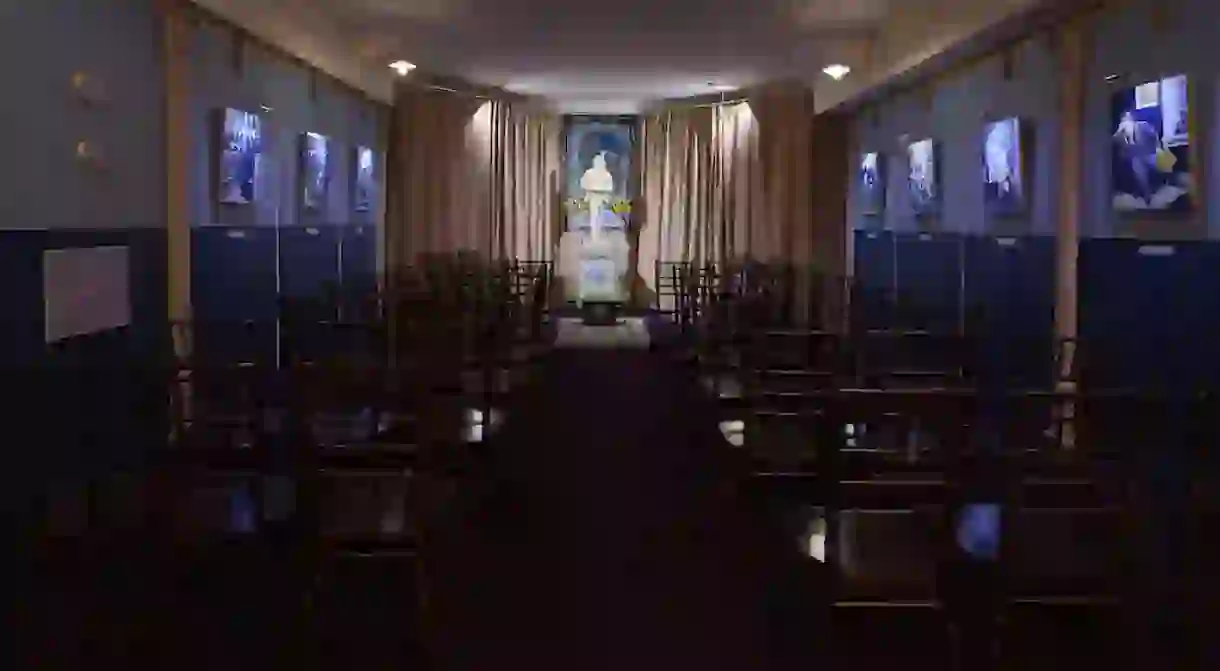Artists Unveil a "Temple" Honoring Oscar Wilde in a Manhattan Church

Housed within a chapel inside a Greenwich Village church, The Oscar Wilde Temple (2017) is a new, site-specific installation by artists McDermott & McGough honoring the famed Irish writer, whose unjust punishment for his sexuality rendered him an early martyr for the gay rights crusade to come. Author of literary masterpieces such as The Picture of Dorian Gray (1890) and The Importance of Being Earnest (1895), Oscar Wilde’s legacy reaches far beyond his superlative talent as a wordsmith.

In May 1895, Wilde was sentenced to two years of hard labor at Reading Gaol (jail) on charges of sodomy and gross indecency. The already acclaimed author, poet, and playwright had ignited a romantic relationship with a young man by the name of Lord Alfred Douglas in 1891, and it was at the hand of Douglas’s father that he was ultimately incarcerated.
“Wilde had tried to sue Sir John Sholto Douglas, father of his lover, Alfred Lord Douglas (or Bosie), for libel after a series of homophobic insults, culminating in a note left at Wilde’s club the Albemarle reading ‘For Oscar Wilde, posing somdomite [sic],’” Emily Gosling summarizes in AnOther.
The writer’s decision to take legal action would be his downfall. The jury acquitted Sir John while evidence of Wilde’s homosexuality, by way of passages from his published texts and private letters exchanged with Lord Alfred, mounted to create a formidable case against him.
The trials ruined Wilde’s reputation, but the sentence destroyed his health. He was released in 1897 and died three years later from acute meningitis, a fatal infection directly linked to an injury he suffered in prison.
Wilde’s immeasurable talent situated his writings amongst the Victorian era’s best, but it was his noble spirit that underscored the impassioned activism of a forthcoming—and ongoing—fight for gay rights. At a time when homosexuality was a criminal offence, Wilde, renowned for his larger-than-life wit and magnetic flamboyance, was an early proponent of freedom of expression.

Well over a century after his passing, Wilde’s story serves as the inspiration for a new installation that celebrates his legacy. The Oscar Wilde Temple was 20 years in the making for McDermott & McGough, the artist duo behind the ambitious multimedia project.
“Wilde’s example as an enemy of homophobia remains a bellwether of modern activism and is the basis of McDermott & McGough’s installation,” reads the press release, “conceived as a welcoming secular space to honor one of the earliest and most courageous forbears in the centuries-long struggle for gay liberation and to celebrate the fight for equality.”
Comprised of paintings, site-specific elements, and an arresting wooden sculpture of Wilde serving as the central altarpiece, the Temple is a monument not only to Oscar Wilde, but to those who followed in his footsteps. Curated by Alison Gingeras and presented in collaboration with the LGBT Community Center and The Church of the Village, the project also includes a series of portraits by McDermott & McGough depicting contemporary ‘martyrs’ of AIDS and homophobia.

“The Temple is to be a place free of religious doctrine, honoring a watershed historical figure who pioneered the long struggle for equal rights for gays, lesbians, bisexual and transgender people—a struggle that has intersected with our nation’s larger effort to acknowledge, accept, embrace, and draw strength from the profound diversity that makes society stronger and enriches the lives of all people,” David McDermott explains.
The touching tribute was unveiled on September 11, fostering a morning of reflection, community, and remembrance. Located inside The Church of the Village, 201 West 13th Street, New York, NY 10011, the Temple is open to the public and will remain on view until December 2, 2017.
On October 1, a retrospective of the artists’ work will go on view at the Dallas Contemporary. In 2018, the Temple will travel to Studio Voltaire in London.













